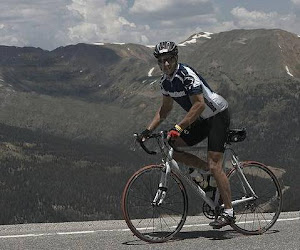
Last night I rode the weekly Thursday Night Derby Ride (ThNDR) from Starbuck's in Doylestown. I met a new guy before the ride (keeping his name anonymous) that was commenting about my friends iBike PM mounted on his handlebars. He seemed to be questioning the utility/usefulness of the iBike. I tried to do my best to explain to him (in less than 2 minutes since it was time to ride) how it worked...and more importantly WHY it worked. I could tell it wasn't sinking in.
Later in the ride, I find out that this NEW guy on the ride is a local HS Physics teacher..that one of my friends (also on the ride) had in school. I couldn't help myself. I said, "Wait a minute, you're a HS Physics teacher and you're bad-mouthing the iBike Power Meter which is probably the most sophisticatd cyling computers ever invented...and considered a Physics/Engineering marvel?" He said, "I don't train with Power I train by Heart Rate and RPE (Rate of Perceived Exertion). " For the record, I have a BS degree in Physics and MS in Engineering and the iBike PM is truly a physics/engineering marvel. For a HS Physics teacher to NOT be interested in its function/capability is beyond me. This guy wasn't the least bit intrigued...rather more skeptical than anything. But, I guess what got to me more than that (the skepticism) was the fact that he said, "I train with a HR monitor or by RPE and that works for me". What I didn't have time to ask (since he peeled off the ride to go home) was, "What does 'that works for me' mean?". Does "works for me" mean riding with a HR monitor for 5+ yrs. and STILL being a Cat 5 racer? (which I found out he was).
Ok, enough of the (geek) Physics Teacher. So, why train and race with a PM? Why is it truly better than a HR monitor or training/racing by RPE? For one thing, HR monitors do NOT give you the complete picture of the body's workload. Nor an accurate picture...since heat, diet, stress, etc. may affect heart rate. Don't get me wrong, I always ride with a HR monitor but it's NOT my primary source of information on my rides or during my races. I use the HR monitor as my tachometer..to tell me when/if I'm redlining. I use the Power Meter for everything else..to tell me how fast I'm going, my power output, my cadence, etc.
So, should you be racing/training with a Power Meter? Should you buy one? Let me tell you what Joe Friel (world renown physiologist/coach) said in his new book, copyright 2009, "The Cyclist's Training Bible"- he said, "If I was your coach you'd HAVE TO". Joe requires EVERY cyclist to use one. He said his athletes are more likely to achieve their race goals by training- and racing- with power than without.
But, just mounting a PM on your bike's handlebars will NOT make you a better (faster/stronger) cyclist...using the data/information that it produces- WILL! The most important data you can get from a PM is the data you obtain from Training Peaks Software's Performance Management Chart (PMC). The PMC will tell you EVERYTHING you need to know about your training/racing. Most importantly, it will tell you HOW you're training.
Attached is a copy of my latest PMC. You can see I'm at a higher fitness level than I was last year at this time. However, my peak power is NOT higher. That is somewhat depressing..after all, we all want to produce higher power peaks from year to year. Don't we? But, there is an explanation for it...that is, I weight 5 lbs. less than I did last year at the same time. Therefore, although my power hasn't risen, my power to weight ratio (w/kg) has...and that's good news. A higher w/kg will make me faster/stronger in the hills. You can also see from the chart that my training ramp rate is NOT as steep as it was last year. There are a lot of reasons for that..the primary one being that the weather was much nicer in March/April last year and I was able to get out on the road more often...logging more miles. Secondly, the CTL/ramp rate is based on your Training Stress Score (TSS). The TSS can NOT differentiate between volume and intensity. That is, I can have a high TSS...thus steep CTL rate, comprised of nothing but high volume low intensity workouts. This year, I'm probably doing just the opposite...spending more of my time on low volume high intensity workouts. The million dollar question is: what's better a shallow or steep ramp rate? The answer: DEPENDS! Depends on who you are, how much you train, what your goals/objectives are, etc. The PMC tells you so much more: how fresh you are, your peak power output, training load and if are you "on form".
Are you training/racing with a Power Meter? Or are you like the geek Physics Teacher that scoffs at the technology? Perhaps, this blog will help him "see the light"...just like Edison.
Power ON! Coach Rob





No comments:
Post a Comment